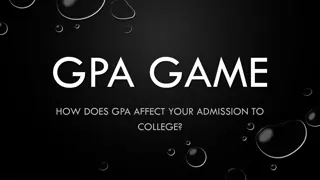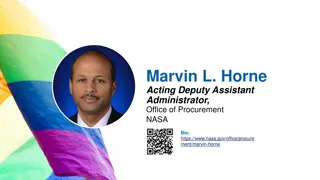Enhancing College Admissions for Equity and Innovation
Explore the need for a redesign in college admissions to address lost enrollments and barriers to access post-pandemic. Learn about Lumina's focus on simplicity, equity, and innovation in admissions processes. Discover how to apply for funding and support interventions for diverse student populations.
Download Presentation

Please find below an Image/Link to download the presentation.
The content on the website is provided AS IS for your information and personal use only. It may not be sold, licensed, or shared on other websites without obtaining consent from the author.If you encounter any issues during the download, it is possible that the publisher has removed the file from their server.
You are allowed to download the files provided on this website for personal or commercial use, subject to the condition that they are used lawfully. All files are the property of their respective owners.
The content on the website is provided AS IS for your information and personal use only. It may not be sold, licensed, or shared on other websites without obtaining consent from the author.
E N D
Presentation Transcript
Sept. 12, 2023 Informational Webinar Presented by: Melanie Heath Strategy Director for Participation
Why the Great Admissions Redesign? Have lost over 1M enrollments in bachelor s programs since the pandemic began; especially pronounced among students of color and Pell-eligible students Test-optional is now the norm, with 80% of colleges not requiring SAT/ACT Recent SCOTUS decision banning race-conscious admissions practices has forced many institutions to reexamine current processes
Why the Great Admissions Redesign? More than that, so many of the barriers to college access are beyond the control of higher education. What IS under our control is our own systems. Let s make them better: simpler, more streamlined, more equitable, and more innovative.
Questions? Luminafoundation.org/admissions-redesign For questions specific to your own institution, system, or project, please email: admissionsredesign@luminafoundation.org
Agenda 1. What is Lumina looking for? 2. Eligibility 3. Funding Types 4. Use of Funds 5. Timeline 6. How to Apply 7. Application Highlights 8. Questions from you!
What is Lumina looking for? Opportunity Simplicity Innovation
Opportunity Complexity is the friend of the privileged. Richard Reeves, Brookings Institute Simpler admissions systems are more equitable, while complex admissions systems are less equitable Demonstrated focus on interventions that aim to support students of color, low-income students, and first- generation students
Simplicity Automation: Limit the work prospective students must undertake to apply Proactivity: Inform prospective students of their educational options before they apply and communicate quickly and efficiently with the applicant Transparency: Eliminate uncertainty in the process to the highest extent possible
Innovation Unique or novel ways of automating processes, recruiting/admitting students, using data to create seamless processes for prospective students, etc. Can mean a fundamentally different process/policy OR existing ideas used in new or interesting ways
Eligibility 1. State agencies and quasi-public organizations 2. State systems of higher education that include public, nonprofit bachelor s-granting universities or colleges 3. A group of three (3) or more public or private, nonprofit institutions of higher learning that includes at least one public or private, nonprofit bachelor s-granting institution(s)
Timeline Milestone Challenge announced Informational webinar Challenge deadline Evaluation window Notification of standing Final proposal submitted Nov. 10 Final notification Dates Sept. 6 Sept. 12 Oct. 6 Oct. 9 to Oct. 17 Oct. 31 Nov. 27
Funding Types: Planning Proposals Up to 5 entities for grants up to $100,000 each 12-month grant period from January 2024 to December 2024 Applicants in the early stages of developing a vision for redesigned admissions, enrollment, and/or financial aid processes Grant period should end with a strong implementation plan and timeline for implementation
Funding Types: Implementation Proposals Up to 3 entities for grants from $500,000 to $750,000 each 23-month grant period from January 2024 to November 2025 Applicants who have piloted efforts or who have the table set, who need resources to enhance, improve, expand, or speed implementation Grant period should end with tangible policy and practice changes and evidence of effectiveness that can serve as a model for others to follow and learn from
Use of Funds Should be spent on strategic investments that fundamentally alter admissions, enrollment, and/or financial aid processes Can include, but is not limited to: Data infrastructure Staffing to build new systems/processes Convening project teams/other stakeholders Hiring consultants Developing new marketing/collateral materials Cannot include: Scholarships or stipends Lobbying or election-related activities
How to Apply Luminafoundation.org/admissions-redesign Application will be available on the website after this webinar
Application Highlights Documents needed: Need EIN/Tax ID number for each entity in the project Need to attach a process map of current and future state for the desired intervention Good to know: Application does NOT save! You must fill it out in a single session. You work will be lost if you refresh the page If your application was successfully submitted, you will see a confirmation screen and project director will receive a confirmation email
Application Questions: Planning Proposal 1. Describe the problem, barrier, and/or place of friction in your current admissions, enrollment, and/or financial aid process this planning proposal would address. 2. Explain how the proposed project will increase educational opportunity for students of color, students from low-income families and first-generation college students. 3. How will the proposed project reduce complexity in admissions and enrollment processes, specifically regarding automation, proactivity, and transparency? 4. Explain how this is a fundamentally new or reimagined way of admitting and enrolling students in higher education. 5. Describe your entity s capacity to execute innovative policies and practices. How do you plan to develop your implementation plan and build the support of needed stakeholders? 6. How would you strategically use the grant funds to plan for an admissions innovation? Why? 7. What does success look like at the end of the grant period?
Application Questions: Implementation Proposal 1. Describe your admissions innovation. Has it been piloted? If so, what were the preliminary impacts on postsecondary participation rates? 2. Explain how the proposed project will increase educational opportunity for students of color, students from low-income families and first-generation college students. 3. How will the proposed project reduce complexity in admissions and enrollment processes, specifically regarding automation, proactivity, and transparency? 4. Explain how this is a fundamentally new or reimagined way of admitting and enrolling students in higher education. 5. What history of success has your entity shown in executing innovative policies and practices that include a well-thought-out implementation plan and the support of needed stakeholders? 6. How would you strategically use the grant funds to implement/expand your admissions innovation? Why? 7. What does success look like at the end of the grant period?
Questions? Luminafoundation.org/admissions-redesign For questions specific to your own institution, system, or project, please email: admissionsredesign@luminafoundation.org























